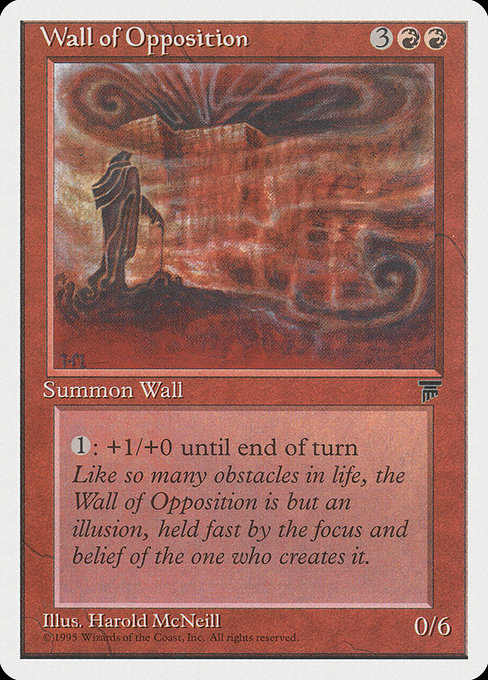
Image courtesy of Scryfall.com
Constraint-Driven Deck Building: A Wall of Opposition Case Study
There’s a strange, delicious magic in letting limits do the heavy lifting for you. In MTG, constraints aren’t just about lockouts and mana curves; they’re the design knives that carve out new strategic paths. Take Wall of Opposition, a red creature from Chronicles that gleefully defies your assumptions about what red can do on the defense. A defender that clocks in at 3 mana plus two red, a 0/6 body that says, in no uncertain terms, “I’m not going anywhere fast, but I’m not going down easy either.” 🧙♂️🔥💎
The card’s essence is a classroom in constraint: you’re paying a heavy mana tax for a sizable, unattackable blocker that rewards you for choosing to pump it with a single mana. Its defender status forbids it from attacking, which might feel limiting at first glance. Yet that limitation becomes the engine of creative deckbuilding. When a wall can’t advance on offense, it must excel at what it can do—hold matters in place, blunt the opponent’s early aggression, and give you a window to pivot toward a different victory path. Wall of Opposition embodies this paradox: a formidable defensive anchor that invites you to build a plan around tempo, protection, or alternate win-cons rather than raw aggression. ⚔️🎨
Card at a glance
- Name: Wall of Opposition
- Mana cost: {3}{R}{R}
- Converted mana cost (CMC): 5
- Type: Creature — Wall
- Rarity: Uncommon
- Set: Chronicles (CHR), a Masters-era reprint
- Power/Toughness: 0/6
- Colors: Red
- Abilities: Defender; {1}: This creature gets +1/+0 until end of turn.
- Flavor text: “Like so many obstacles in life, the Wall of Opposition is but an illusion, held fast by the focus and belief of the one who creates it.”
- Artist: Harold McNeill
Two design choices stand out here. First, the defender keyword locks Wall of Opposition into a purely defensive role. Second, the pump ability gives you a lever to occasionally flip the script—one mana to push its power for a short while, potentially allowing a surprise block or a last-minute hold in a stall situation. In a format and era where red decks tend toward speed and direct damage, Wall of Opposition flips the script: it asks you to pause, protect, and plan for the long game. The art and flavor text reinforce that philosophy—obstacles can be illusions, until you choose to move past them with a disciplined, constraint-led strategy. 🧙♂️🔥
Why constraints often unlock better deck design
Constraints function like a creative sparring partner. They force you to articulate what you’re willing to lose and what you’re trying to achieve. In Wall of Opposition’s case, the obvious cost is tempo and aggression. The payoff is reliability and resilience. By embracing the constraint of a wall that can’t attack, a designer (and a player) must explore secondary lines of victory: stall-and-win with a crescendo of pump spells, leverage recurring damage with direct-damage options, or build a deck that thrives on attrition and clever combat tricks. That mindset—designing around the constraint rather than trying to overpower it—often yields more interesting, memorable games. 🧩🎲
Consider how you might craft a constraint-driven archetype around this card today. A possible approach is a red control-leaning shell that uses Wall of Opposition as a reliable roadblock while you deploy card advantage engines, selective removal, and a subset of finishers that don’t require your wall to attack. The {1} pump becomes a micro-tool for killing through when the timing is right, turning a stalemate into a decisive swing. And even if your tempo is modest, the wall buys precious turns to set up a more potent game plan—think of it as buying time with style and a bit of chaos. 🔥⚔️
Practical play and deck-building tips
If you’re chasing constraint-driven success with Wall of Opposition, here are a few practical ideas to consider:
- Pair the wall with red’s efficient temporary buffs and mana advantage spells to press through once you’ve stabilized. A single +1/+0 trigger can be the difference in trading with a mid-sized threat. 🔁
- Lean into a control-forward approach: use removal, bounce, and disruption to keep the opponent from leveraging their early threats while your wall stands firm.
- Explore alternate win conditions. Since the wall won’t attack on its own, you’ll want a backup plan—perhaps a big spell, a token generator, or a surprise finisher that doesn’t rely on your creatures attacking every turn.
- Be mindful of the mana curve. Wall of Opposition demands a five-mana commitment. Design your mana base to ensure you reach that critical turn five with options, not just a single explosive play.
- Appreciate the kit’s lore. The Chronicles era is a reminder that constraints were baked into early MTG design, often producing some of the most enduring, if quirky, creatures in the sandbox. The flavor text reminds us that the “illusion” of obstacles can be real if you let them be. 🧪
In the broader arc of deck design, Wall of Opposition stands as a reminder that better decks aren’t born from unlimited options, but from disciplined constraint. The card teaches patience, the art of stalling for a purpose, and the clever use of a single mana to bend a moment in your favor. It’s a little paradox baked into a single green-tinged wall (well, red in this case) that still has fans arguing about its place in the history books. And that’s the beauty of MTG—a game where constraint isn’t a closed door, but a doorway to richer, more inventive storytelling. 🧙♂️💎⚔️
For readers who want to explore more gear and inspiration, the product below offers a delightful cross-promotion moment that keeps you plugged into a broader gaming lifestyle—without stepping too far from the table where your next strategy unfolds.
Phone Case with Card Holder MagSafe Compatible Slim Polycarbonate
More from our network
- https://blog.digital-vault.xyz/blog/post/legends-of-theros-nessian-hornbeetles-power-unlocked/
- https://crypto-acolytes.xyz/blog/post/crypto-trading-bots-for-gamers-useful-or-risky/
- https://blog.digital-vault.xyz/blog/post/streamlining-project-management-with-notion-and-airtable/
- https://transparent-paper.shop/blog/post/advanced-youtube-seo-strategies-to-boost-watch-time/
- https://blog.digital-vault.xyz/blog/post/distant-o-type-star-unfolds-its-6-solar-radius-via-photometry/